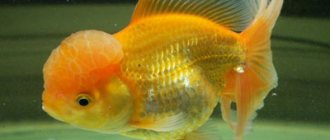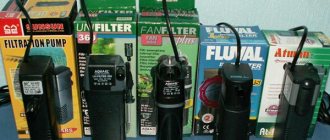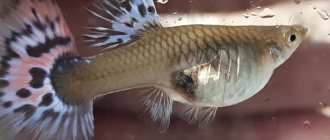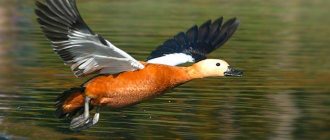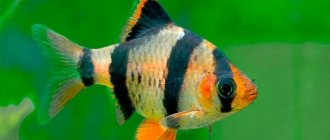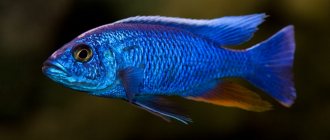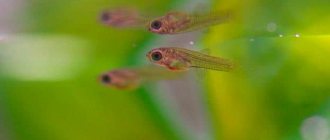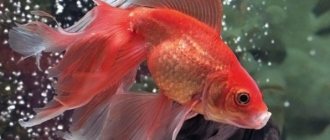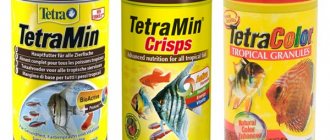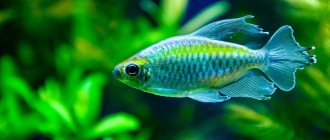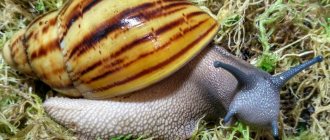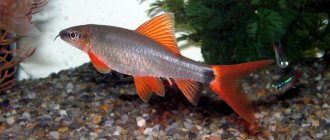What to consider when keeping aquarium fish
Amazing, bright and active aquatic inhabitants of aquariums can live in fresh or sea water; it is necessary to create comfortable conditions for them; predatory and non-carnivorous representatives of the fauna cannot be kept in the same container. How to properly place it in a modern interior, see the website.
The main conditions for keeping aquarium fish are to maintain optimal water temperature, timely cleaning and replacement, oxygen enrichment and disinfection, choosing the correct volume of the aquarium and nutritious food, and organizing a normal diet.
Feeding the fish
The main condition for feeding fish is a balanced diet. But you cannot overfeed them, because they may die. Food is usually poured once a day, but so that there is enough for all the pets to eat.
Underfeeding is also fraught with the death of the inhabitants. Before you start feeding, tap on the glass of the aquarium so that the fish develop a conditioned reflex. At this time they will begin to huddle together and wait for food to appear. It's a funny sight. Feed at the same time, then you will not get confused with feeding.
The main food of fish are:
- Artificial feed;
- Frozen or live bloodworms;
- Plant food;
- Shredded squid and shrimp;
- Special dust for fry.
Change your diet daily. The portion is set as the food is eaten. If you see that there is food left after feeding, it means there is a lot of it. Excess food pollutes the water and rots at the bottom. Fasting days can be arranged for pets once every half month.
Temperature maintenance
Keeping certain types of fish requires maintaining a certain level of temperature; taking into account the compatibility of keeping aquarium fish, it is necessary to select the inhabitants of the same aquarium and, if necessary, place them in different containers.
The general rule concerns the avoidance of sudden changes in water temperature, which often causes diseases in aquatic inhabitants, so it is recommended to equip the aquarium with an internal thermometer and monitor the air temperature in the room where the aquarium is installed.
Compatibility with other fish
When selecting neighbors, consider the compatibility of the fish. They can be compatible, partially compatible (goldfish and catfish converge differently) and completely incompatible (predators and peaceful ones, large and small). The following compatibility criteria are distinguished:
- family;
- size;
- accommodations.
Select fish of a similar size with similar requirements for temperature, acidity, water hardness, composition and nutritional standards.
Other inhabitants
Snails, shrimp, crayfish or aquarium frogs are added to the neighborhood of aquarium fish. Snails crawl along the bottom, decorations and clean their habitat from food waste and mucus.
Small fish, such as guppies and neons, are compatible with shrimp. The others try to eat them.
Only small and nimble fish that can swim away from its claws, such as guppies, get along with crayfish. Bright, large species attract crayfish, crawling along the bottom too. He hunts them.
Dwarf, artificially bred frogs are also sometimes added to fish. But they have high requirements for acidity and water hardness. It is better for a beginner not to start them.
Quality and hardness of water in the aquarium
Carbonate hardness of water is the main indicator of quality, so before filling the aquarium it is necessary to check its composition, which will help avoid diseases of fish and invertebrates and lead to the normal development of vegetation.
Regular water purification is carried out thanks to the connection of specialized pump devices, the additional function of which is to enrich the liquid with oxygen; in case of reduced hardness, special compounds are added to the water or harmless shellfish are placed.
Heater and thermometer
A novice aquarist cannot do without a heater (heater). Why do you need a heater in an aquarium?
For a comfortable life, the inhabitants of a home pond need water at a certain temperature. It is extremely difficult to create the necessary conditions without a heater: in the hot summer or during the season when heating is on in the apartment, the water will be warmer, in the off-season it will be colder. Both of these can lead to the fish starting to get sick. For this reason, the heater is just as important as the filter and compressor, and is included along with them on the list of must-have equipment for an aquarium.
To monitor the water temperature, purchase a thermometer along with the heater.
However, it is not enough to heat the water - the desired temperature must also be maintained. How to do it? There are two options:
- After the device has heated the water to the required temperature, unplug it. When it falls, turn it on again - and so on constantly. However, this is not very convenient, so more often aquarists choose the second method.
- To maintain the desired microclimate in the aquarium, it is better to purchase a heater with a thermostat. This device automatically maintains a constant temperature in the tank and prevents temperature fluctuations.
Heaters with thermostats are either electronic or mechanical. The former are more accurate, but are more expensive. When choosing, also take into account the power of the device and select one that matches the volume of your aquarium.
In addition to the above equipment, the future aquarist should purchase:
- a net - it is needed to catch fish;
- a scraper and a hard sponge - these will help when cleaning the tank.
Oxidation, purification and water change
The oxidation of the liquid directly depends on the timely cleaning of the aquarium, on the walls and bottom of which waste products of fish and decay of vegetation can accumulate; there are various options to neutralize this factor.
White representatives of the aquatic kingdom are rightfully considered orderlies and cleaners; in addition to them, small organisms that purify water can be bred in the aquarium, and it is important to determine how keeping a comet or labeo aquarium fish will affect the lives of other fish representatives.
Diseases and prevention
Most aquarium fish have strong immunity. The main causes of diseases in aquarium fish are:
- deterioration of water quality;
- infection;
- severe contamination and an increase in the number of pathological bacteria.
If, when examining fish, you see passive fish lying on the bottom, moving strangely, with strange spots or plaque on the body or fins, look for the reason. If necessary, accommodate separately.
The most popular diseases are discussed in more detail here
Neighborhood of different species of fish and plants
The fish in the aquarium do not require complex and daily care; if the proximity of representatives of flora and fauna is properly organized, all species should optimally combine with each other and not pose a threat to each other.
In one aquarium it is better to gather lovers of fresh or salty, warm or cold water; schooling fish feel great in a high and voluminous aquarium, and for catfish it is better to choose a flat and shallow container; some love plant thickets, while others prefer stones and houses.
What plants to choose for an aquarium
The more diverse the aquatic plants, the better. After all, each of them is also food for fish. Some pets gnaw at algae, and there are some that lay eggs on the leaves.
There are also those who do not pay any attention to algae. But do not forget to thin out the bushes and remove rotten leaves. They also need to be washed under running water to prevent plaque from forming on them.
When changing the water in the aquarium, do not leave elongated algae without water, they are also alive and may die.
Choosing the right food for pet fish in an aquarium
Nutrition and diet are very important for fish, so choosing food appropriate for the representatives of the aquatic kingdom placed in the aquarium requires special responsibility, and it is necessary to focus on their taste preferences.
Having the ability to absorb liquid, dry food can become a threat to the life of fish, so they must be combined with live and frozen food; you cannot overfeed the fish; excess and uneaten food settles on the walls and decor of the aquarium, decomposing and polluting the water.
Choosing pets before purchasing
The choice of fish is a crucial moment. It is impossible to select the inhabitants of a home pond just by appearance. You need to decide on pets before purchasing an aquarium. For a beginner, it is better to choose medium-sized inhabitants with low maintenance requirements. You should not start aquarium farming right away with whimsical species, since in the first stages it is difficult to avoid mistakes that will be disastrous for delicate creatures. Before purchasing from a pet store, knowing the name of the fish you need, you should ask the seller how to care for aquarium fish of this type, whether it is possible to breed them, and what conditions they need. This is especially important if information on a particular species has not been obtained in advance.
According to the rules of aquarium farming, fish placed in the same aquarium must have uniform requirements for water quality and feeding, and also not be aggressive towards each other. It is advisable to select pets that are close in size and temperament, otherwise they will be extremely uncomfortable in each other’s company. It is unacceptable to house predatory and peaceful fish in the same container. Such a neighborhood is detrimental to herbivorous fish. If they are not swallowed right away, they will be wounded and die.
Look at the beautiful predatory fish.
Many fish are schooling. You cannot have them in pairs, but you must buy at least 6 individuals. Beginners do not always like this feature of pets, as it gives the impression that the abundance of identical fish in the aquarium will become uninteresting. In reality, the view of the reservoir is exquisite.
When buying fish, you need to carefully examine them. The presence of wounds and defects in the scales is an indicator that they cannot be purchased. They also do not take sluggish individuals with improper swimming. It is optimal to buy fish that are not yet sexually mature, which will grow in a home aquarium and better adapt to specific conditions. In the future, they can be used for reproduction if the owner wants to breed them.
Feeding the fish
Feeding of most species is organized according to the same rules. It is better for fish to undereat than to overeat. Gluttony leads to obesity and chronic inflammation of the pet's intestines. Feed is thrown in the morning and evening at the same time. Large fish, having become accustomed to the owner, begin to take food from the hands. Before feeding, be sure to wash your hands with laundry or antibacterial soap.
The portion of food is given so that the fish can eat it within 5–7 minutes. Excess is removed. Excess food will spoil the water, starting to rot between the stones. The menu needs to be varied. Feeding the same food will negatively affect the condition of the fish.
Ideally, fish nutrition should combine:
- live food;
- frozen food;
- dry food from daphnia and gamarus;
- artificial dry food.
It is useful to feed your pets with scalded lettuce leaves and seafood, such as squid and shrimp, twisted through a meat grinder. Predatory species will also need meat food. They are given meat twisted through a meat grinder and sea fish.
A delicacy is egg yolk, given boiled. It can muddy the water, which is why it is given before weekly cleaning and in small quantities. Large species are partial to earthworms, which are soaked in water to remove soil and cut into pieces. Live dust, sold in pet stores, is used to raise fry.
Care, water replacement, decoration
When setting up a home pond for the first time, it is important for beginners to learn how to care for fish in an aquarium. There are recommendations for caring for an aquarium. Care is a regular matter, and when getting fish, you should remember this. Cleanliness in the reservoir is necessary for the life of the inhabitants and the absence of an unpleasant odor in the apartment. A dirty aquarium gives off a swampy smell.
Caring for water requires its partial replacement. You should change 20% of the water in the aquarium weekly. New water is prepared in advance. It is collected in a glass container 2 days before the shift and, after standing for 36 hours, it is brought to the required parameters using chemical reagents.
The water change is carried out in parallel with cleaning the bottom using a special siphon. He, like a vacuum cleaner, will pick out all the dirt between the stones. Next, use a scraper to clear the walls of mucous deposits that form colonies of bacteria, and then pour in clean water.
Watch the video about all the nuances of changing aquarium water.
Decorative elements installed on the bottom are cleaned once every 2 weeks with a brush. They are taken out, washed and returned to their place. The use of detergents is prohibited. You cannot ignore cleaning the decor, as this will cause a gradual disruption of the water balance, and this leads to cloudiness of the water and a deterioration in the condition of the fish.
You need to take care of your aquarium at home regularly, adhering to the established rules, and then care and maintenance will not be burdensome. Aquarium fish compensate their owner for their care and attention with their beautiful and healthy appearance.
Observation
The aquarium as a whole performs a decorative function, but its inhabitants are living beings that require attention. Keeping aquarium fish requires a competent approach. The owner should inspect them daily, and not just glance at them. If changes are noticed in the behavior of any of the fish, it is necessary to prepare a quarantine aquarium and remove the changed fish for further observation and, if necessary, treatment.
If a disease is detected, keeping fish that require treatment in a community aquarium is highly undesirable. For healthy fish, medications are not needed and will only harm them. Depending on the condition of the fish, treatment can be carried out with complete isolation or temporary for procedures that do not take more than 30 minutes.
Aquarium keeping is a fascinating activity that, if you properly organize your home pond and know how to properly care for an aquarium, will give you a variety of positive emotions. Proper care of the aquarium and fish for beginners will be the key to their success in aquarium farming.
Interesting videos about aquarium fish and their contents
AdminAuthor of the article
Did you like the article?
Share with your friends:
Starting an aquarium
Before you get fish, it is necessary to establish biological balance in the reservoir, because pets are not placed in a new, just launched tank. It is also important to know what kind of water to put in the aquarium.
So, the first start of the aquarium - where to start:
- the reservoir is filled with water, checking the integrity of the seams;
- lay out the soil, plant the plants;
- install decorations and decorations;
- include equipment.
The biological balance is established within a week, and at this time aquarists finally decide on the fish and buy pets. In order for water parameters to normalize, professionals advise diluting conditioners and mineral fertilizers in the water, about which you can separately consult with specialists.
As soon as the biological balance in the tank is normalized, you can introduce the first inhabitants of the reservoir - frogs for the aquarium, mollusks or shrimp. They will tell you if everything is okay with the aquatic environment, and within a week they will stock the fish.
Proper nutrition - healthy pets
The most important thing a novice aquarist needs to know is what food to buy and how to feed his little friends.
Typically, aquatic inhabitants eat frozen and dry food mixed with plant food and bloodworms. But frozen bloodworms are best suited for these purposes; they are easily digestible by most fish.
You should never overfeed the inhabitants of the “underwater kingdom”, because with this procedure you can cause them great harm. Their life expectancy may be significantly reduced. The behavior of aquatic pets affects their health indicator. If the fish begin to behave less well, such an alarm should lead to a decrease in their nutrition or even a slight starvation.
You can develop a conditioned reflex in fish. To do this, lightly tap the glass with a fingernail so that the inhabitants of the water depths swim to the surface of the tank. Many animals get used to this regime and can swim up to get food on their own at the same hour.
Caring for aquarium fish is not difficult, but it requires a certain amount of time, effort and inspiration every day.
Basic mistakes of newbies
The main rule for breeding a particular fish is to have enough space for all the little ones. Sometimes newbies make a huge mistake and overpopulate the water tank. For fertilization, fish require a large space and a lot of stones and decorations to hide from other individuals.
How to choose an aquarium: tips on how to choose the right size, material and shape. Necessary equipment for aquariums (100 photos)Types of aquarium fish: 150 photos of the most popular and unique inhabitants of aquariums
- Keeping aquarium fish: rules, regulations, recommendations and tips for beginners (140 photos and videos)
In addition, creatures are capable of dying out if their genotype does not develop or the males are infertile. To do this, it is important to cross fish of different breeds, where there will be no likelihood of closely related relationships.
The last item should be fish food, which does not have to be Premium. Breeders without experience often spend money on expensive bags of food, while forgetting about other maintenance items. It is enough to select food for fish according to the principle of composition. The composition should contain vitamins, minerals, acids and other beneficial substances.
Replacement of vessel fluid
Keeping aquarium fish at home is not difficult. One of the main factors for the safe living of marine life is water, which must be settled.
The water needs to stand for about two to three days. During this time, the bleach has time to evaporate and the liquid reaches the proper level of purity.
In order not to waste so much time, the water can be heated to seventy degrees and cooled to room temperature. This also helps get rid of excess oxygen, which is harmful to aquarium inhabitants.
Water for the aquarium needs to be left for 2-3 days.
Preventative cleaning of the aquarium should be carried out no more than once a week and not in full. Do not change the fluid frequently or completely. Fresh water must be added little by little and only after the bottom of the vessel has been previously cleaned.
If the liquid in the aquarium begins to become cloudy, do not immediately panic, since in some cases this is due to the remains of dry food, and not due to the growth of bacteria.
In such cases, you should do the following:
- clean the bottom of the vessel from dirt;
- do not feed fish with dry food for a while;
- completely evacuate marine animals until their habitat is restored.
If the cloudiness does not go away after some time, it is worth doing a comprehensive cleaning of the vessel.
Choosing a tank
Before thinking about creating an underwater kingdom, it is necessary to organize convenience and comfort for its inhabitants. Living conditions in the tank should be as close as possible to the natural environment. Therefore, you should first study our material, which describes detailed recommendations on how to choose an aquarium and equipment for it.
The most important thing: do not forget that an artificial “reservoir” is, first of all, a home for living organisms, and only then an element of decor.
Accessories and equipment
In specialized stores, artificial ponds are sold together with covers or nets intended for attaching equipment. They also protect overly active fish so that the pets do not jump out of the aquarium. Lids are often equipped with lighting fixtures, which is very convenient. It should be noted that the power of the built-in lamps may not be suitable for certain phenotypes, so it is better to immediately clarify all the nuances in the store.
To get fish and plant plants, an aquarium for beginners must be equipped with the following equipment:
- light bulbs;
- heaters;
- thermometer;
- ultraviolet lamp for aquarium;
- filter;
- additional osmosis in the aquarium;
- siphon for aquarium;
- an aerator that supplies oxygen to the aquarium.
This is a list of standard equipment, without which it is impossible to start a reservoir. Additionally, they buy aquarium charcoal, shelves for food, various trinkets, and air stones. Also, various decorations are purchased for the aquarium to decorate the tank: grottoes, shelters, caves, models of sunken ships and boats, pebbles and driftwood.
